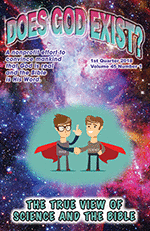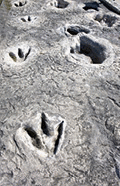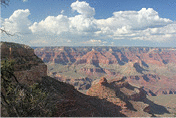Return to 1st Quarter 2018 articles.


As you read fundamentalist materials on the Creation and atheist materials refuting creation, you see them making the same error. Both are adding human traditions and assumptions to what they find in the Bible. Some of this comes from denominational traditions and some from second-hand information. In the past ten years discoveries have challenged both creationists and atheists to find a way to fit their belief systems into the mountain of new data. I am talking about data, not theory or opinion. Religious extremists may attempt to deny the data, but in the twenty-first century, that is increasingly difficult to do because everyone can see the evidence for themselves.
All of this data leads any thinking person to realize that his view of the cosmos must accommodate the facts. Some of these facts are very complex and have implications that are not easy to ignore. Some of the interesting facts are these:
- The Earth is not the physical center of the cosmos.
- The Earth orbits the Sun, one star of the billions that make up our Milky Way galaxy, and along with these stars
....in the galaxy, orbit the core of the galaxy.- There is dark matter/energy holding galactic systems together.
- Space has shape and gravity (mass) can warp that shape.
- Stars vary in type and function, and they can even explode.
- Distances in space are huge and some objects are so far away that it takes millions of years for light to get from
....them to us.- There are other solar systems with planets orbiting their parent stars, some of which could have liquid water on
....their surfaces.- Matter in the physical world obeys physical laws. The energy and electromagnetic forces that produce charge and
....mass have their own set of laws and do not always obey the physical laws.
So how do fundamentalists and atheists deal with these facts and others we have not listed? Atheists suggest theories which provide a possible explanation, but are scientifically and mathematically impossible. Frequently they do that by redefining words so  that their attempt to discard or discredit God can be accomplished. An example would be to redefine “life.” Life has traditionally been defined as “that form which can move, breathe, respond to outside stimuli, and reproduce.” In the September 2017 issue of Astronomy magazine (page 10), Dr. Bob Berman makes the statement that, “Scientists can't agree on a definition.” Atheist Francis Crick who was the codiscoverer of the DNA helix describes the origin of life as “almost a miracle, so many are the conditions which would have to be satisfied to get it going.” Some suggest life in the form of rocks, gases, or latent energy. These creative proposals are not science. They cannot be tested or falsified in any way, so they are simply guesses with no scientific validity. Another example is the word “nothing” which has been redefined to attempt to maintain that something can come from “nothing.” What most rational people accept as nothing is different from those proposals.
that their attempt to discard or discredit God can be accomplished. An example would be to redefine “life.” Life has traditionally been defined as “that form which can move, breathe, respond to outside stimuli, and reproduce.” In the September 2017 issue of Astronomy magazine (page 10), Dr. Bob Berman makes the statement that, “Scientists can't agree on a definition.” Atheist Francis Crick who was the codiscoverer of the DNA helix describes the origin of life as “almost a miracle, so many are the conditions which would have to be satisfied to get it going.” Some suggest life in the form of rocks, gases, or latent energy. These creative proposals are not science. They cannot be tested or falsified in any way, so they are simply guesses with no scientific validity. Another example is the word “nothing” which has been redefined to attempt to maintain that something can come from “nothing.” What most rational people accept as nothing is different from those proposals.

To deny God's participation, some have proposed a creation process that is not science at all because it cannot be falsified. No experiment can test the idea to see if it is valid. Virtual reality is a classic example of this. “Virtual” means “unreal.” A virtual image cannot be projected. It depends on perceptions, with the brain being the major player. You can propose anything in the virtual world, so it is, in essence, a religious proposal with no purpose or use except to exclude God. In some cases like string theory or brane theory, the proposal may be real, but it is untestable. There are 10 500 different solutions to the equations in string theory making it impossible to test on any practical level. If you want further explanation, there is an excellent book by Leonard Susskind titled The Cosmic Landscape: String Theory and the Illusion of Intelligent Design (New York: Little, Brown and Company, 2006).
Religious fundamentalists have several methods of dealing with scientific facts. One is the method we have already discussed, and that is to make proposals that have no scientific credibility and cannot be falsified nor tested in any way. They simply say, “God did it” or “God spoke it into existence.” This method is very popular because it avoids science completely. All of the questions raised about evolution, dinosaurs, or cavemen are simply swept away. As popular as this method is, it has severe problems. The most glaring problem is that it violates the Bible. Peter tells us to, “Always be prepared to give an answer to everyone who asks you to give the reason for the hope that you have. But do this with gentleness and respect” (1 Peter 3:15 NIV). Throughout the Bible, God tells us to look at the creation and learn and build our faith (Job 38-41; Psalm 19:1; Proverbs 8; Romans 1:18-20).
There is another major problem with avoiding scientific facts. Doing so puts us out of touch with both what we see Jesus and the apostles doing in their day and with what a majority of people in our day accept as reasonable. When Jesus went into the temple at age twelve, he reasoned and studied with the leaders of the temple. That was his pattern throughout life. When Paul was in Athens on Mars Hill, he debated and discussed with the Epicureans and Stoics. He also taught and spoke in the synagogues and schools throughout his ministry. So too, in our day, we must teach people where they are in their understanding. All studies show that a large percentage of people in the Western world say “none” when asked what their religious beliefs are. When pollsters ask why people have left their Christian beliefs, a majority either say it has no relevance to their lives or that their questions have not been answered.

Another method that religious fundamentalists use to deal with scientific facts is to offer claimed scientific evidence to refute the facts. The reason this works is that a large percentage of the world's people are scientifically illiterate. Several religious organizations attempt to deny the existence of dinosaurs or show that dinosaurs and humans lived together. A classic example of this was a claim that human and dinosaur tracks were found together  in the same rock strata in Glen Rose, Texas. To support this belief, biblical words were distorted, facts about the tracks were kept hidden, and alterations of the tracks were kept secret. We visited the tracks in 1976 and had an article on them in our journal (September 1976, page 2). One of the main fundamentalist groups that promoted the Glen Rose effort made a film titled, Footprints in Stone which was finally recalled (September 1986).
in the same rock strata in Glen Rose, Texas. To support this belief, biblical words were distorted, facts about the tracks were kept hidden, and alterations of the tracks were kept secret. We visited the tracks in 1976 and had an article on them in our journal (September 1976, page 2). One of the main fundamentalist groups that promoted the Glen Rose effort made a film titled, Footprints in Stone which was finally recalled (September 1986).
This same kind of problem exists with many claims and organizations today. Great distances and long time intervals are handled by using scientific claims that simply do not work. Suggesting time dilation or advocating relativistic speeds during the creation week ignores the fact that mass increases in the same way that time dilates. Claiming that the speed of light in a vacuum has changed radically ignores the fact that the value of this constant is used in a plethora of equations describing other phenomena. Claiming Noah's flood produced the rocks in the Grand Canyon and  then eroded them “as the waters abated” ignores the fact that most of the rocks in the canyon are not flood deposits. Skeptics have produced flashy journals like Skeptic magazine in which God and the Bible are ridiculed because of errors such as these.
then eroded them “as the waters abated” ignores the fact that most of the rocks in the canyon are not flood deposits. Skeptics have produced flashy journals like Skeptic magazine in which God and the Bible are ridiculed because of errors such as these.
Most of these religious attempts to deal with scientific facts come from non-biblical doctrinal traditions such as dispensationalism, millennialism, rapture theology, Jehovah's Witness doctrines, Mormonism, spiritism, or others.
So what is “the true view of science and the Bible” as our title suggests? How can we convince people living in the twenty-first century that God does exist, that the Bible is the Word of God, and that Jesus Christ is the way, the truth, and the life and that no one comes to the Father except through him? (See John 14:6.) We would suggest that four fundamental statements need to be accepted before one begins to look at the evidence:
- The Bible and science have to agree because they have the same Author.
- Science is knowledge and is true by definition.
- God wants us to study the creation and learn from it (Psalm 19:1; Proverbs 8:1, 22-28; Romans 1:18-20).
- The Bible is inspired and true but must be read by looking at who wrote the passage, when and why it was written,
....and how the people it was written to would have understood it (2 Timothy 3:16-17).

Atheists and skeptics will want to deny all but number two. Fundamentalists will want to deny all four statements. They will deny number four because their view of the Bible is that the Spirit makes the King James Version accurate for all people as written in all ages. To rational, educated twenty-first century people who are searching for answers, these four statements make sense and can be used as a guide to build a dynamic, working, functional faith. This ministry is designed to assist people in building faith. We can assist by helping people understand words in the original language. We can assist by debunking bad science and pointing out so-called scientific statements from both atheists and fundamentalists which clearly are not scientific. We can share the knowledge of great scientists who are believers, both in the past and in today's world. We do not claim to be infallible in attempting to do this, but we would suggest the approach has been time-tested. We have been in this ministry for 50 years now and offer these materials free of denominational bias, tradition, and without cost. Welcome.
Picture credits:
Cover composite by Roland Earnst: © NASA images and © Aleksei-Veprev. Both images from BigStockPhoto.com
© NASA images. Image from BigStockPhoto.com
© Warrior3d. Image from BigStockPhoto.com
© Maxim_o. Image from BigStockPhoto.com
© W.Scott McGill. Image from BigStockPhoto.com
© W.Scott McGill. Image from BigStockPhoto.com
Photo: Roland Earnst
© Aleksei-Veprev. Image from BigStockPhoto.com
Scripture links/references are from BibleGateway.com.
